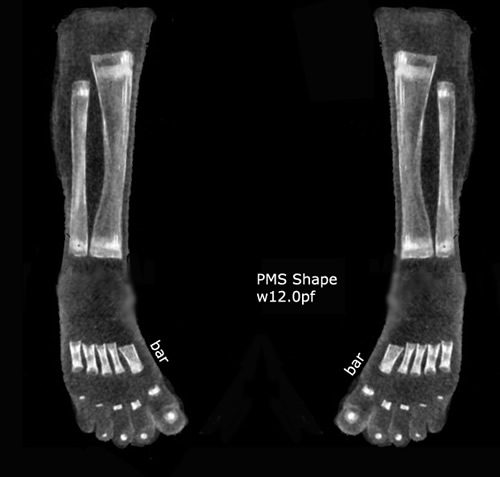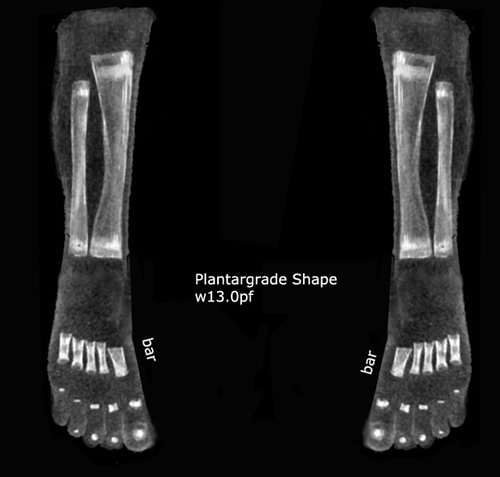Positive Health Online
Your Country

Etiology of the Clubfoot, PreClinical Clubfoot, Primus Metatarsus Supinatus Deformities
by Brian A Rothbart PhD(more info)
listed in bodywork, originally published in issue 279 - June 2022
Introduction
Congenital talipes equinovarus (CTEV), to this day, has no general consensus as to its’ etiology in normal newborns. Many theories have been proposed, including such factors as increased intrauterine pressure, smoking, family history as well as genetic.
This study encompasses the sequential examination of the prenatal foot plates during late embryogenesis and early fetalgenesis in which the foot inchoates as a limb bud and then progresses through a series of forms, clubfoot to plantargrade. If the foot’s ontogenetic growth is prematurely arrested during this time of prenatal development, the infant is born with a Clubfoot Deformity, a PreClinical Clubfoot Deformity or a Primus Metatarsus Supinatus Foot Deformity, depending at which stage the abortive ontogenesis occurred.
Discussion
The prenatal foot develops in a specific and predictable way. It first appears as a limb bud, Carnegie Stage 15 (35-38 days post fertilization). [Figure 1]

Figure 1. Embryo, Carnegie Stage 15
Passing through Carnegie Stages 17-19 (41-51 days pf) the plantar surfaces of the foot pads rotate inward from a cephalad position [Figure 2] to a vertical position [Figure 3].

Figure 2. Embryo, Carnegie Stage 17

Figure 3. Embryo, Carnegie Stage 19
At this stage, the soles of the feet are facing one another (e.g., in supinatus). At Carnegie Stage 23 (56-60 days pf), [Figure 4] the developing foot has a clubfoot shape. [Figure 5]

Figure 4. Embryo, Carnegie Stage 23

Figure 5. Clubfoot shape
It continues its’ torsional growth, progressing through a preclinical clubfoot shape (Figure 6) and a primus metatarsus supinatus shape [Figure 7], until it reaches its’ adult (Plantargrade) shape [Figure 8].

Figure 6. Preclinical Clubfoot shape

Figure 7. Primus Metatarsus Supinatus (Rothbart) shape

Figure 8. Plantargrade shape
If any of these prenatal shapes persist into the postnatal foot, they are considered deformations, and are so named. They are The Clubfoot Deformity, the PreClinical Clubfoot Deformity and the Primus Metatarsus Supinatus Deformity (aka Rothbarts Foot).[1]
During foetalgenesis, if we were to look inside the womb and watch the foot’s torsional growth unfold in real time, this is what we would observe:
At approximately week 8 (56-60 days post fertilization), the foetal foot has a clubfoot shape. Specifically, the embryological medial and lateral columns of the feet are structurally twisted inward, that is, in supinatus. If the torsional growth is arrested at this stage, the baby is born with a CTEV (Clubfoot Deformity).[2]
At approximately week 9pf, the foetal foot has a preclinical clubfoot shape. The lateral column supinatus (the inward structural twist of the cuboid, intermediate and lateral cuneiforms, four lesser metatarsals and respective phalanges)is no longer present. The calcaneal supinatus (the inward structural twist of the heel bone) is decreased, but the medial column supinatus (the inward structural twist of the talar head and neck, navicular, internal cuneiform, 1st metatarsal, proximal phalanx and hallux) persists. If the torsional growth is arrested at this stage, the baby is born with a Preclinical Clubfoot Deformity.[3]
At approximate week 10pf, the foetal foot has a primus metatarsus supinatus shape. The calcaneal supinatus is no longer present. The medial column supinatus persists but has decreased. If the torsional growth is arrested at this stage, the baby is born with a Primus Metatarsus Supinatus Deformity.[4]
This structural deformation was recently been confirmed in a weight bearing computed tomography study in which a rotational position (supinatus) was recorded in all the medial column bones in patients with different foot and ankle problems,[5] in a weight-bearing Case-Control cadaver study[6] and in a non-weight-bearing cadaver study.[7]
A protocol was developed to accurately measure the medial column supinatus using calibrated microwedges underneath the 1st metatarsal head.[8] A single blind study involving 4 examiners and 32 volunteers tested the accuracy of this technique, resulting in an intrarater and interrater reliability ranging from 0.90 to 0.95. The authors concluded that this measuring protocol was reliable.[9]
At week 36pf, the prenatal foot has nearly completed its torsional growth. The medial column supinatus is no longer present. The baby is born with a Plantargrade foot (the soles of the feet are perpendicular to plumb line of the body).
Summation
- Based on the sequential analysis of the embryo’s foot plates, it can be extrapolated that if the foot’s torsional development is arrested at approximately week 8pf, the baby is born with a Clubfoot Deformity;
- If the foot’s torsional development is arrested at approximately week 9pf, the baby is born with a PreClinical Clubfoot Deformity;
- If the foot’s torsional development is arrested at approximately week 10pf, the baby is born with a Primus Metatarsus Supinatus (aka Rothbarts Foot) Deformity;
- If the foot’s prenatal development is completed, the baby is born with a Plantargrade (normal) foot.
References
- Hartz R, Biancalana M: Medial Foot Column Disorders (Morton’s and Rothbart’s): Endemic, Underdiagnosed, and Undertreated. The Journal of Pain: 20 (4): 70-72. 2019.
- Streeter GL. Developmental horizons in human embryos. In contributions to Embryology. Vols 21, 32, 34. Washington D.C., Carnegie Institution of Washington. 1945, 1948, 1951
- Rothbart BA. Medial Column Foot Systems: An Innovative Tool for Improving Posture. Journal Bodywork and Movement Therapies (6)1:37-46. 2002.
- Rothbart BA. The Primus Metatarsus Supinatus (Rothbarts) Foot and the PreClinical Clubfoot Deformity. Podiatry Review, Vol. 67(1). 2010.
- Schmidt E.Silva T., Baumfeld D. et.al. The Rotational Positioning of the Bones in the Medial Column of the Foot: A Weightbearing CT Analysis. Iowa Orthop J. 2021:41(1):103-109. 2021.
- Dibbern K., Briggs H., Behrens A., et.al. Reliability of coronal plane rotation measurements in the medial column of the foot: a cadaveric study. Journal Foot and Ankle 15(3):252-260. 2021
- Camacho D., Ledoux W. et.al. A three-dimensional, anatomically detailed foot model: A foundation for a finite element simulation and means of quantifying foot-bone position. Journal of Rehabilitation Research and Development. Vol.39(3):401-410. 2002.
- Rothbart BA. Medial Column Foot Systems: An Innovative Tool for Improving Posture. Journal Bodywork and Movement Therapies (6)1:37-46. 2002.
- Cummings G.S., Higbie, J. A weight bearing method for determining forefoot posting for orthotic fabrication. Physiotherapy Research International, Vol 2(1):42-5. 1997.
Comments:
-
No Article Comments available